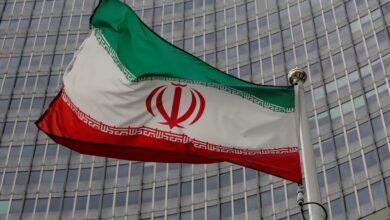Iran denies US destroyed an Iranian drone near Persian Gulf
Iran on Friday denied President Donald Trump's statement that a United States warship destroyed an Iranian drone near the Persian Gulf after it threatened the ship, an incident that marked a new escalation of tensions between the countries less than a month after Iran downed an American drone in the same waterway and Trump came close to retaliating with a military strike.

The Iranian military said all its drones had returned safely to their bases and denied there was any confrontation with a US vessel the previous day.
“We have not lost any drone in the Strait of Hormuz nor anywhere else,” tweeted Deputy Foreign Minister Abbas Araghchi.
The strait is at the mouth of the Persian Gulf and serves as the passageway for a fifth of all global crude exports; a clash there highlights the risk of war between Iran and the US.
Trump on Thursday said the USS Boxer took defensive action after an Iranian drone closed to within 1,000 yards of the warship and ignored multiple calls to stand down.
Trump blamed Iran for a “provocative and hostile” action and said the US responded in self-defence. Iran’s foreign minister, Mohammad Javad Zarif, told reporters as he arrived for a meeting at the United Nations that “we have no information about losing a drone today”.
After Trump pulled the US out of the Iran nuclear deal last year and imposed economic sanctions on Tehran, the Iranians have pushed back on the military front, shooting down a US drone on June 20.
Also in the past weeks, the Persian Gulf region has seen six attacks on oil tankers that the US has blamed on Iran, and a tense encounter between Iran’s Revolutionary Guard and the British navy. Iran has denied involvement in the attacks or the British naval encounter.
The US has also sent thousands of additional troops and increased its security presence in the region.
Adding to the economic pressure on Tehran, the Treasury Department said on Thursday it was imposing sanctions on what it called a network of front companies and agents involved in helping Iran buy sensitive materials for its nuclear programme. It said the targeted individuals and entities are based in Iran, China and Belgium.
The Pentagon said Thursday’s incident happened at 10am local time in international waters while the Boxer was transiting the waterway to enter the Persian Gulf. The Boxer is among several US Navy ships in the area, including the USS Abraham Lincoln, an aircraft carrier that has been operating in the nearby North Arabian Sea for weeks.
Neither Trump nor the Pentagon spelled out how the Boxer destroyed the drone. CNN reported that the ship used electronic jamming to bring it down rather than hitting it with a missile.
In Tehran, the semi-official Tasnim news agency quoted military spokesman Gen. Abolfazl Shekari as saying that “all Iranian drones that are in the Persian Gulf and the Strait of Hormuz, including the one which the US president mentioned, after carrying out scheduled identification and control missions, have returned to their bases.”
The Iranians and Americans have had close encounters in the Strait of Hormuz in the past, and it’s not unprecedented for Iran to fly a drone near a US warship.
In December, about 30 Iranian Revolutionary Guard vessels trailed the USS John C. Stennis aircraft carrier and its strike group through the strait as Associated Press journalists on board watched. One small vessel launched what appeared to be a commercial-grade drone to film the US ships.
Other transits have seen the Iranians fire rockets away from American warships or test-fire their machine guns. The Guard’s small fast boats often cut in front of the massive carriers, running dangerously close to running into them in “swarm attacks”. The Guard boats are often armed with bomb-carrying drones and sea-to-sea and surface-to-sea missiles.
Thursday’s incident was the latest in a series of events that raised US-Iran tensions since early May when Washington accused Tehran of threatening US forces and interests in Iraq and in the Gulf.
In response, the US accelerated the deployment of the Lincoln and its strike group to the Arabian Sea and deployed four B-52 long-range bombers to the Gulf state of Qatar. It has since deployed additional Patriot air defense missile batteries in the Gulf region.
Shortly after Iran shot down a U.S. Navy drone aircraft in June, Trump ordered a retaliatory military strike but called it off at the last moment, saying the risk of casualties was disproportionate to the downing by Iran, which did not cost any US lives.
Iran claimed the US drone violated its airspace; the Pentagon denied this.
Zarif said on Thursday that Iran and the US were only “a few minutes away from a war” after Iran downed the American drone. He spoke to US-based media on the sidelines of his visit to the UN.
“We live in a very dangerous environment,” he said. “The United States has pushed itself and the rest of the world into probably the brink of an abyss.”
Zarif blamed Washington for the escalation and said that the Trump administration was “trying to starve our people” and “deplete our treasury” through economic sanctions.
Earlier on Thursday, Iran said the Revolutionary Guard seized a foreign oil tanker and its crew of 12 for smuggling fuel out of the country, and hours later released video showing the vessel to be a United Arab Emirates-based ship that had vanished in Iranian waters over the weekend.
The announcement cleared up the fate of the missing ship but raised a host of other questions and heightened worries about the free flow of traffic in the Strait of Hormuz, one of the world’s most critical petroleum shipping routes. One-fifth of global crude exports pass through the strait.




